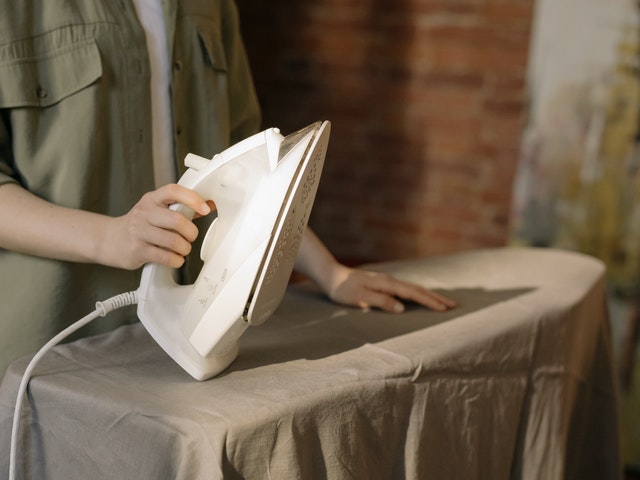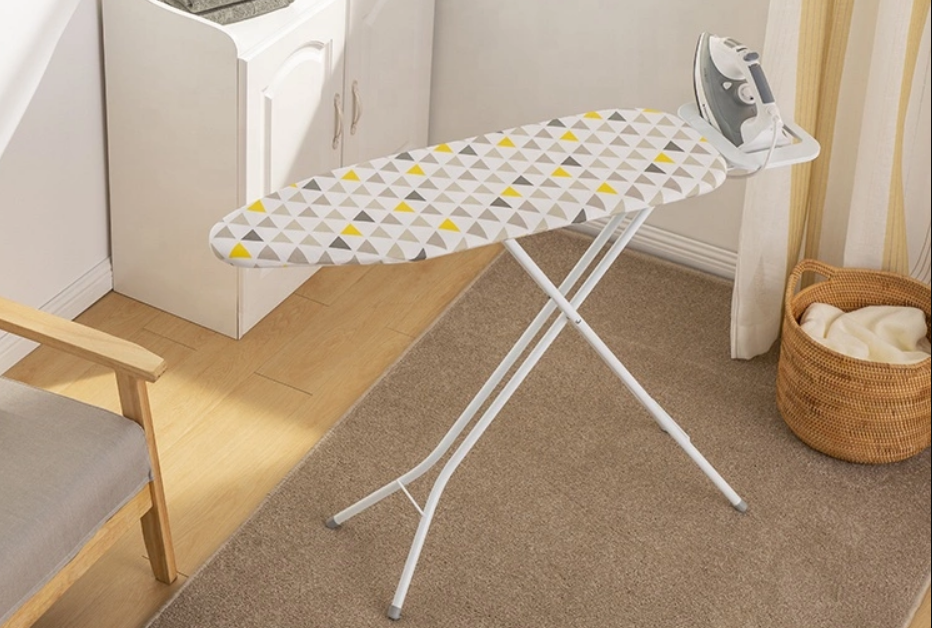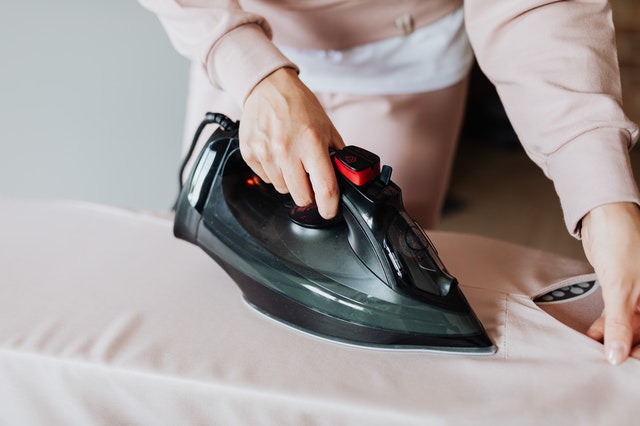Once a commonly performed task, ironing clothes and using an ironing board has fallen out of style, particularly for younger people. Regardless of your age, as we’ve developed a more relaxed and remote working culture, there has been less and less of a reason to use an iron than ever before. In this article, we’ll explain how to use an iron board.
If you’re someone that has an upcoming event, looking to apply for a new job, or simply wants to know how to use the darn thing, you’ve come to the right place. We’ll go over what an iron board is and what it’s used for, how you can most effectively iron your clothes, as well as how to keep your ironing covers clean so that you’re never dealing with dirty or wrinkled clothes again!
What is an Ironing Board?
As the name implies, an ironing board is a flat surface used to iron and straighten out clothes. While it may seem obvious now, that wasn’t always the case. In Ancient China, the process for ironing clothes was practically a three-man job, with two people stretching the clothes out in mid-air while the third ironed the clothes out, using a pan iron. The Vikings progressed to using whalebone smoothing boards, while the Koreans would use stone slabs.
Even in the U.S. and the U.K., ironing boards were only relatively recent in our overall history, as even as early as the 19th-century women would often use makeshift ironing boards such as kitchen tables, ironing tables, and even boards held up by two chairs.
It was only in the mid-1800s that the foldable ironing board that we all know and love came onto the scene.
Different Types of Ironing Boards
For many people that don’t know much about how to use an iron board, it may come as a shock that there are a few different types to choose from, each with its perks and benefits based on the situation. These include Full-Size Ironing Boards, Tabletop Ironing Boards, and Built-in Ironing Boards.
Full-Size Ironing Boards
The most common type of ironing boards, Full-Sized Ironing Boards are also known as “floor standing” and “foldable” ironing boards. They are the ones sold at most stores and what the vast majority of people use for their clothes. They are largely portable and can be used immediately. They often have foldable legs and can be mounted to a wall when not in use.
Depending on the quality of the ironing board, you can get the more basic and standard option or the ones with additional features added on, like a shirt hanger or an iron holder. Most quality boards will generally have the option to adjust the height to better accommodate the person.
Tabletop Ironing Boards
A much less commonly used version of the full-size ironing boards, the tabletop ironing boards are small boards meant to be placed on a table. While not nearly as large as the full-sized options, tabletop ironing boards are ideal for individuals that want their clothing ironed more firmly.
Tabletop ironing boards come in two different versions. There are the more standard foldable option, which is simply a smaller version of the larger full-sized option, and the non-foldable option. The non-foldable ironing boards are more sturdy and also support steam ironing in exchange for not being as mobile.
Built-in Ironing Boards
The built-in ironing boards are often in more modern homes and apartments. They take a bit from the tabletop as well as the full-sized ironing boards and are considered by many as the best of both worlds. As the name implies, they are built into one of the walls of a home, also giving them the name “wall-mounted ironing boards.” Because they are attached to a wall, they require virtually the same amount of space as a tabletop ironing board while being almost as large as a full-sized ironing board.
Wall-mounted Ironing Board
A wall-mounted ironing board is an ironing board that is mounted on the wall and has no legs. The wall mounted ironing board usually allows you to fold the panel away when not in use. This type is suitable for installation in a dedicated space, such as a laundry room or other room. This iron board is currently being used in most hotels, and in addition to home users, many of our project-based customers are also using it as a commercial ironing board.
What to Look Out For in a Quality Ironing Board
While most people would have you believe that all ironing boards are created equal, when you stop and ask yourself what is an ironing board used for, you begin to realize that this isn’t true. For example, tabletop ironing boards are largely meant for precise and firm ironing sessions, whereas full-sized ironing boards are great for general ironing due to their larger size.
There are certain things you want to be on the lookout for when it comes to a quality ironing board. These include cover quality, ironing surface, and load-bearing capacity.
Cover Quality
Arguably the most important aspect of a good ironing board is its cover. A poor-quality ironing cover will almost assuredly result in burn marks on your clothes. You want a cover that has good padding to properly press onto the clothes to more effectively iron out any wrinkles.
Ironing Surface
In addition to a quality cover, you also want to make sure your ironing board has a good surface length and width to iron on. A quality ironing board won’t be too large or too small, nor will it be unreasonably wide or narrow. It should be able to handle and accommodate a variety of different clothing and fabric sizes without making the process particularly inconvenient for you.
Load-bearing Capacity
Finally, you want to use an ironing board with a good amount of weight loading capacity. This simply means how much weight can the ironing board reasonably support. Having one that can support between 10-15kg (22-33 lbs.) will be ideal as it will ensure you will be able to effectively iron your clothes without fear of the board collapsing due to the weight being applied.
How to Use an Iron Board
Now that you’ve got a good idea as to the different types of ironing boards out there and what you should use to get the best results for your situation, now’s the time to go over how to use an iron board. We’ll go over the best ways to iron shirts, pants, and skirts. We’ll also go into the different temperature settings you’ll want to consider when dealing with various fabric types.
Ironing Shirts
Depending on who you are, you’re most likely going to deal with shirts over everything else. Luckily, shirts are pretty easy once you know what you’re doing:
- First:Lay the shirt flat onto the ironing board while opening out the shirt cuffs and the collar. While some people do iron with the cuffs and collar down, if you want your shirt properly wrinkle-free, your best bet is to have everything open so that each area can be individually ironed out.
- Second:Start ironing the sleeves out first. From there, begin working your way up to the other parts of the shirt body. This is ideal as the sleeves will naturally hang down, keeping them from wrinkling again while you work on the rest of the shirt.
- Third:Work on the shirt cuffs and collar. You’ll want them to be ironed completely flat. Just be careful with the front of the cuffs so that you don’t accidentally melt the buttons.
- Fourth:Finally, let the shirt hang for a few minutes to allow the heat to fully dissipate while also allowing the shirt to fully stiffen from the ironing.
Ironing Pants
Pants are similarly pretty easy, though they do require slightly more work on your end to do them just right.
- First:Lay the pants onto the ironing board. Make sure you have them folded lengthwise. This ensures that the side creases are properly matched. If you can’t find the creases, try aligning the side seams with one another.
- Second:Iron entirely up the length of the pants, stopping roughly 6 inches below the waistband. This ensures that the elasticity of the waistband isn’t affected by the iron’s heat. You’ll also want to make sure that you’re pressing down with some level of gentle firmness so that both sides are equally ironed out.
- Third:Place on a hanger and let cool for around an hour or two.
Ironing Skirts and Dresses
Finally, skirts and dresses are by far the easiest due to the nature of the fabric material. That said, you’ll want to use a lower temperature while ironing these to prevent them from burning.
- First: Lay the skirt or dress out onto the ironing board and make sure that it is straightened.
- Second:When ironing skirts, you’ll want to iron from the top and move down to the bottom, either working vertically or horizontally as you go. When ironing a dress, you’ll similarly start from the top (in this case, the collar) before moving down. You’ll initially go over the sleeves before making your way down to the rest of the dress.
- Third:Once you’ve ironed out any wrinkles, let it hang on a hanger and cool for about 5-10 minutes.
Ideal Temperatures Based on Fabrics
In addition to understanding how to use an iron board for clothes, you should also be aware of the proper temperatures each fabric should ideally be ironed at.
Cotton
Cottons should be ironed at high heat while slightly dampened. This ensures the clothing is fully ironed out while also refraining from suffering any actual burn marks on the clothing. The best way to prevent this is by starting at lower temperatures and gradually increasing over the ironing process.
Silk
Silk clothing should ideally be ironed while using a warm iron while the material is slightly damp. You don’t need to iron from the inside out but you should make sure not to use an especially hot iron, as high temperatures can quickly damage silk materials.
Linen
Linens should be ironed from the inside out as well as the proper right-side in. This ensures they have a quality sheen to them, particularly if they are whites or bright colors. If you are ironing darker-colored linens, simply iron them inside out.
Wool
Wool clothing should be turned inside out with a moderately warm iron. Similarly, you can also steam iron wool clothing.
Acrylic
Since acrylic is such a fragile material, you must never use a hot iron as well as any steam or wet options. You want to use the lowest settings while also ironing the clothes from the inside out. It may also be worth it to consider using a higher quality iron.
Polyester
Polyester clothing should be as close to completely dry as possible. You also want to have your iron at the lowest temperature possible. Even moderately high amounts of heat can damage its surface.
How to Wash Ironing Board Covers
The process for washing your ironing board covers is fairly simple and straightforward. In most instances, you’ll set up your ironing board as normal before removing the cover. From there, check to see the proper method for washing it. If it can be washed through the washing machine, simply follow the instructions listed on the cover while using a mild detergent and cold water and setting on delicate.
If the cover must be hand-washed, you’ll want to use a stain remover or stain removal mixture to spot treat any stains on the cover. Spray the solution onto the stains and let sit for 5 or more minutes before wiping with a damp cloth. A great stain removal mixture includes water, vinegar, and baking soda.
Finally, hang up the wet cover or set it on a drying rack. Never put in a drying machine as this will damage the cover’s coating and cause it to shrink. Only put back on the board once the cover is completely dry.

